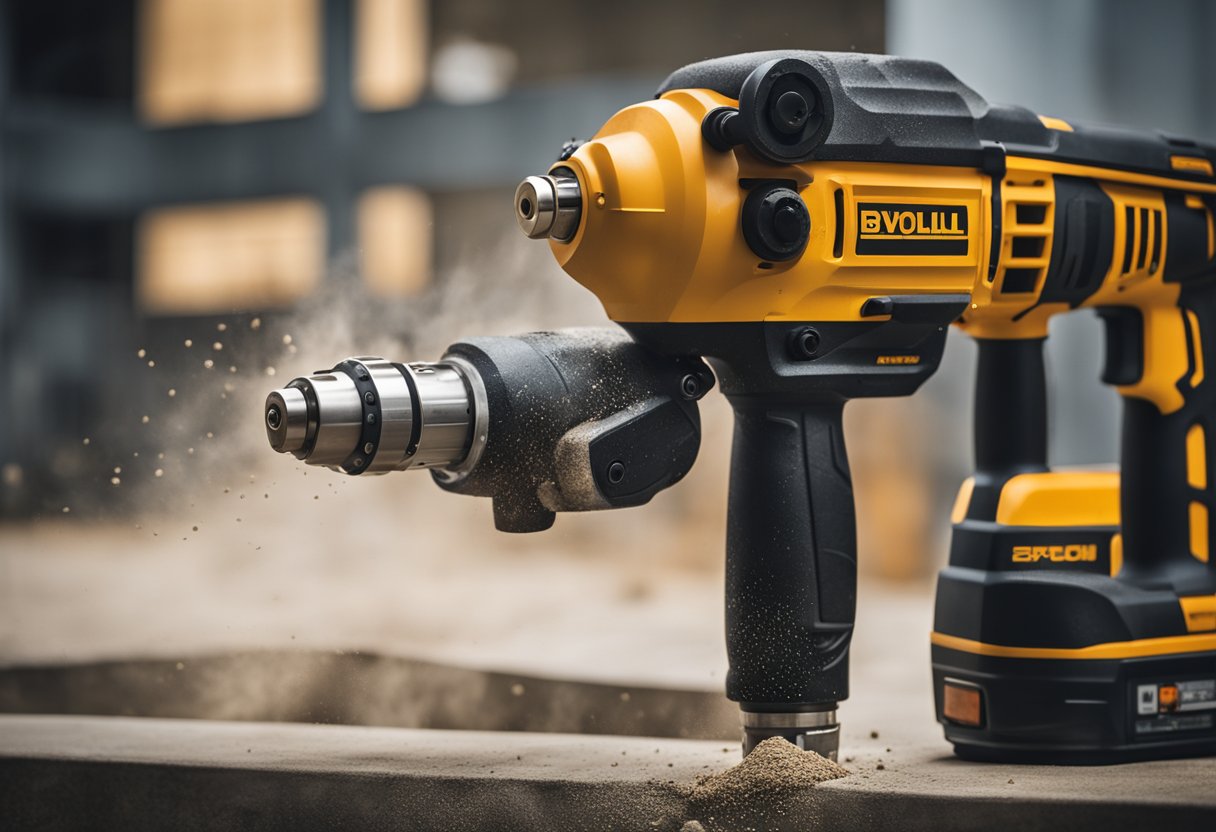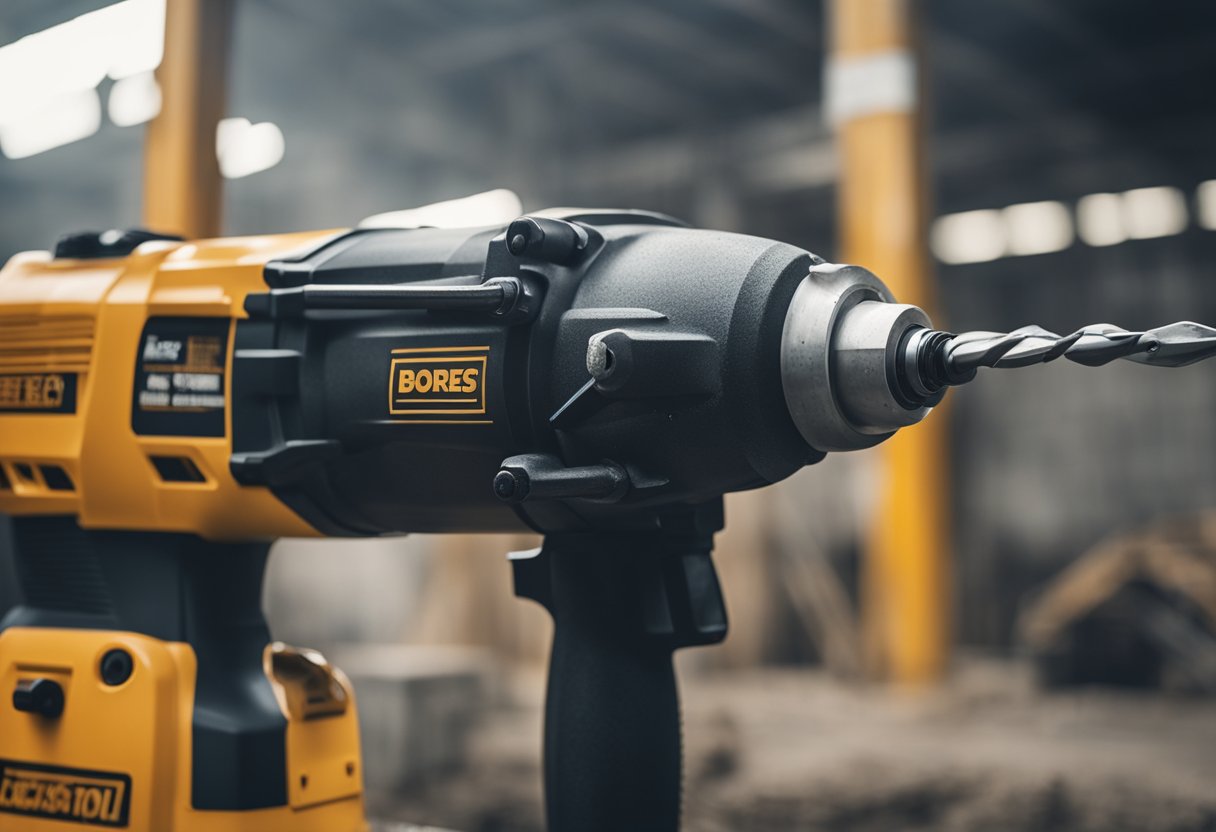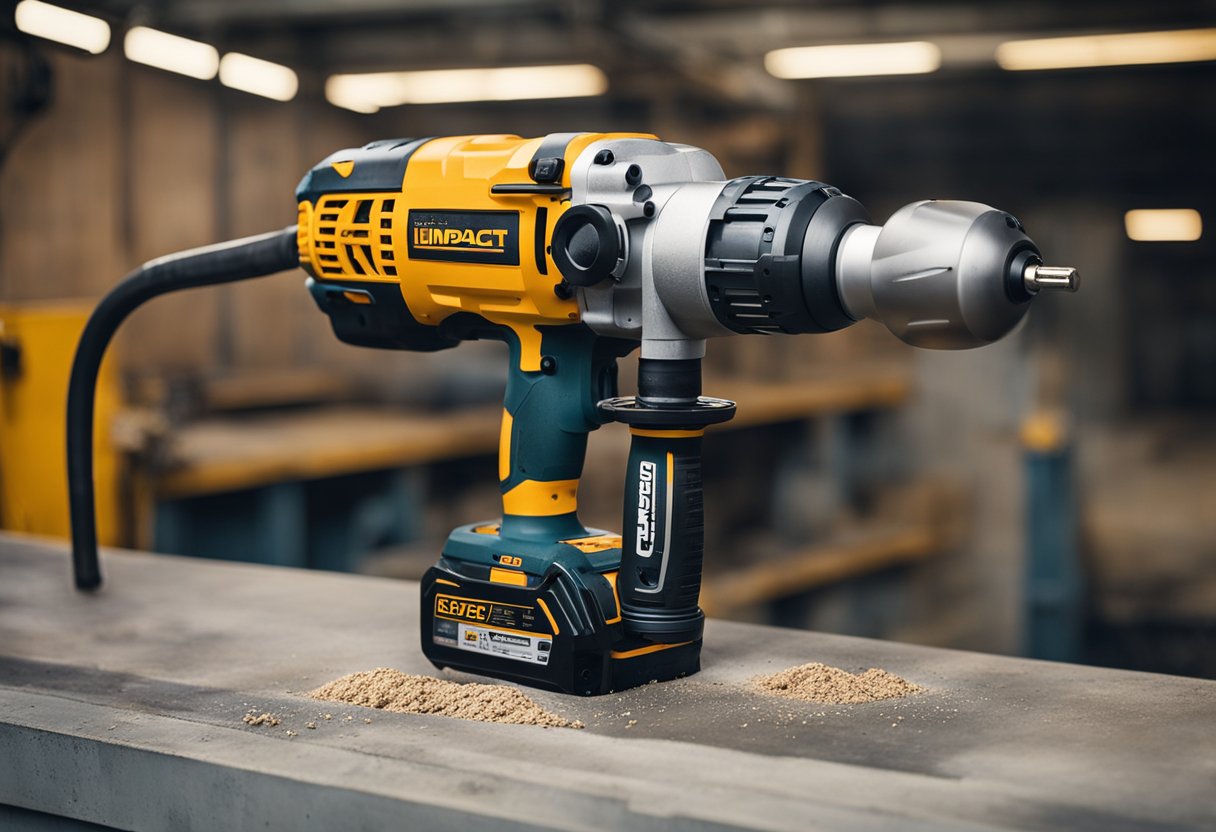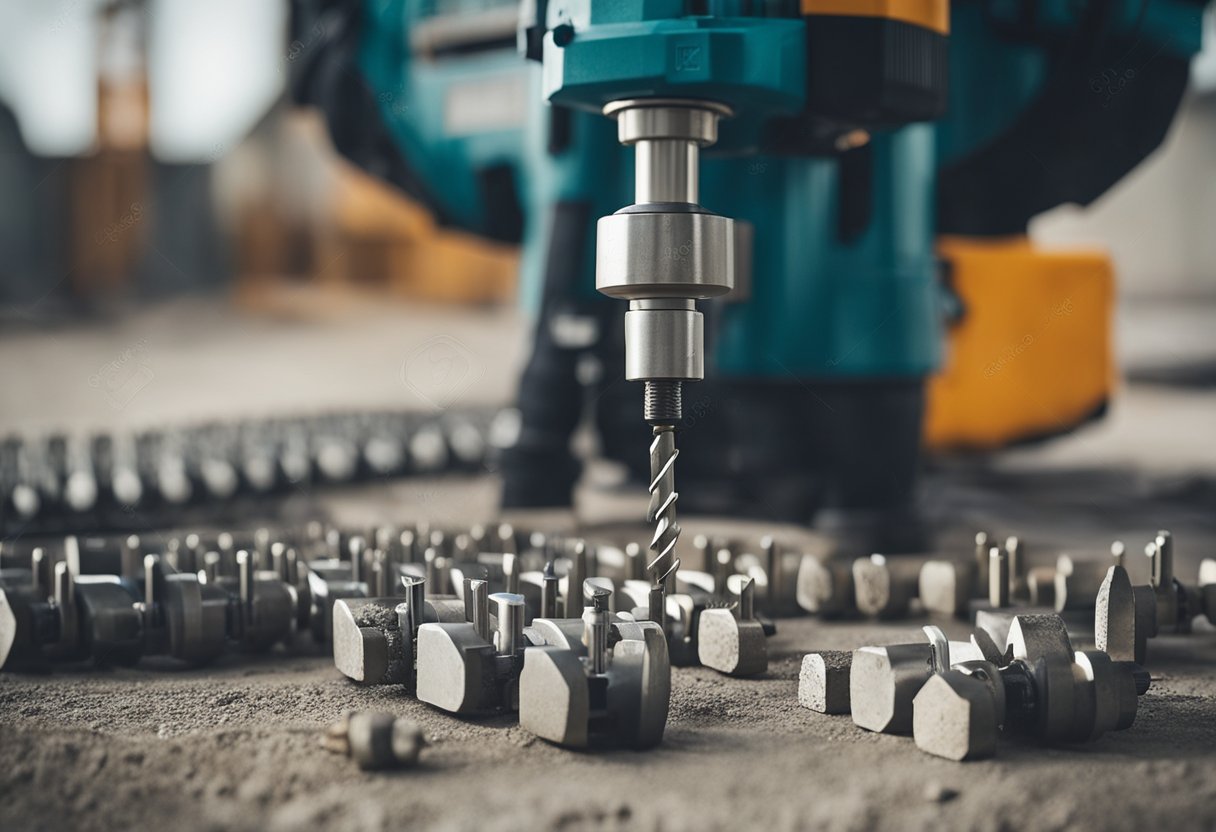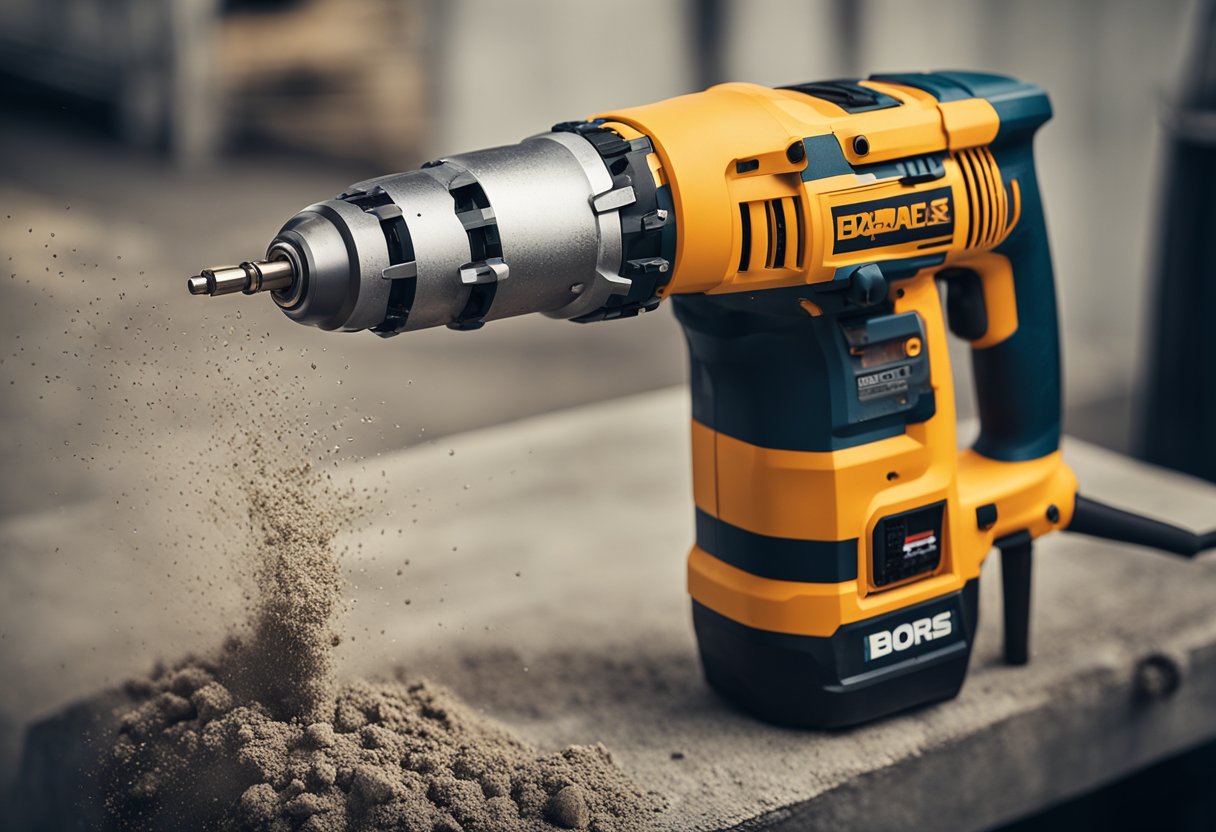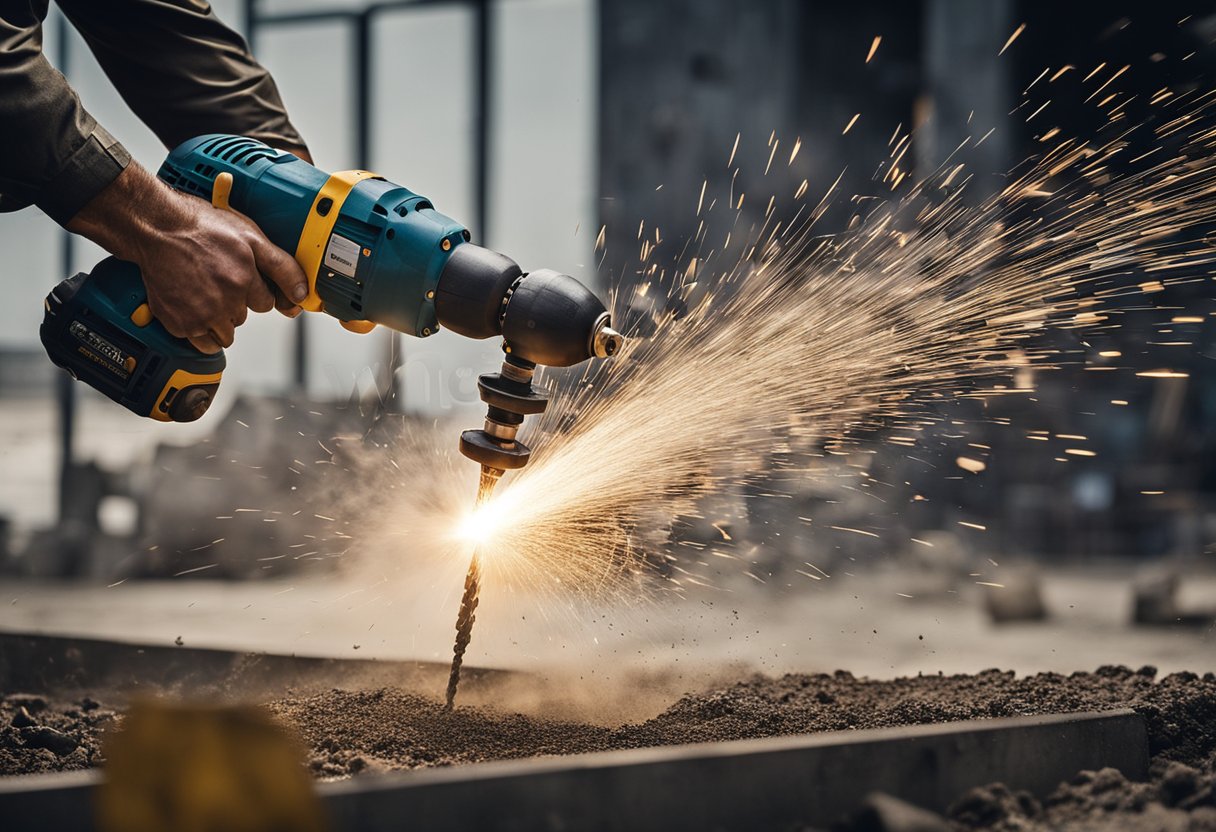As a homeowner or DIY enthusiast, you may find yourself in need of drilling into concrete at some point. Concrete, being a hard and dense material, requires a special type of drill to get the job done effectively. This is where an impact drill comes in handy.
An impact drill is a powerful tool that uses a combination of rotational force and percussive blows to drill through tough materials like concrete and masonry. It is an essential tool for any construction or renovation project that involves drilling into hard surfaces. In this article, I will provide an overview of impact drills for concrete, including what they are, how they work, and what to look for when choosing the right one for your needs.
Key Takeaways
- Impact drills are powerful tools that use a combination of rotational force and percussive blows to drill through tough materials like concrete and masonry.
- When choosing an impact drill for concrete, it’s important to consider factors such as power, speed, torque, and chuck size.
- To ensure safety and efficiency when drilling into concrete, it’s important to use the right drill bit, apply the right drilling technique, and wear appropriate safety gear.
Understanding Impact Drills
https://www.youtube.com/watch?v=usuXK9CL6Ns&embed=true
As an expert in power tools, I can confidently say that an impact drill is a versatile tool that is commonly used in DIY projects and construction sites. An impact drill is a handheld power tool that delivers high rotational force and hammering action to drive screws and drill holes into various materials, including concrete.
Compared to a hammer drill, an impact drill is smaller, lighter, and more compact, making it easier to handle and maneuver. It also has a powerful motor that delivers high torque and rotational force, making it ideal for tough jobs like drilling into concrete.
One of the advantages of an impact drill is its ability to reduce user fatigue. Unlike a hammer drill, an impact drill has minimal vibration and noise, which makes it more comfortable to use for extended periods. This is because an impact drill uses a combination of rotational force and hammering action to drive screws and drill holes, which is more efficient and requires less effort from the user.
It is important to note that an impact drill is not the same as a rotary hammer. While both tools are designed for drilling into concrete, a rotary hammer is more powerful and has a hammer-only mode that delivers more force than an impact drill. However, a rotary hammer is also heavier and more expensive than an impact drill, making it less practical for DIY projects.
In summary, an impact drill is a powerful and versatile tool that is ideal for drilling into various materials, including concrete. It is lighter, more compact, and more comfortable to use than a hammer drill, making it a popular choice for DIY enthusiasts and professionals alike.
Choosing the Right Drill Bit
https://www.youtube.com/watch?v=Lo7veFXq29A&embed=true
When it comes to drilling into concrete, choosing the right drill bit is crucial. Using the wrong drill bit can lead to ineffective drilling, damage to the drill bit, and even damage to the drill itself. Therefore, it is important to select the appropriate drill bit for the job at hand.
One type of drill bit that is commonly used for drilling into concrete is the masonry bit. These bits are made of carbide and are designed to handle the tough and abrasive nature of concrete. Masonry bits come in various sizes and lengths, so it is important to choose the right size for the hole you need to drill.
Another type of drill bit that is commonly used for drilling into concrete is the SDS bit. These bits are designed to fit into SDS drills, which are specialized tools used for drilling into concrete and other hard materials. SDS bits have a carbide tip and are available in various sizes and lengths.
In addition to choosing the right type of drill bit, it is also important to consider the material the bit is made of. Carbide is a popular material for drill bits used for drilling into concrete because it is durable and able to withstand the abrasive nature of concrete. Steel bits, on the other hand, may not be as effective for drilling into concrete and may wear down more quickly.
In summary, when choosing a drill bit for drilling into concrete, it is important to consider the type of bit, the size and length of the bit, and the material the bit is made of. By selecting the appropriate drill bit for the job at hand, you can ensure effective drilling and avoid damage to your tools.
Drilling Into Different Materials
https://www.youtube.com/watch?v=UBucx57pj68&embed=true
When it comes to drilling into different materials, it’s important to choose the right tool for the job. Impact drills are versatile tools that can be used for drilling into a variety of surfaces, including concrete, masonry, brick, metal, wood, stone, and hardwood.
When drilling into concrete, masonry, or brick, it’s important to use a carbide-tipped masonry bit. These bits are designed to withstand the hardness of these materials and are less likely to break or become dull. It’s also important to use a hammer drill or rotary hammer drill, which provides the necessary power to drill through these hard surfaces.
When drilling into metal, it’s important to use a high-speed steel or cobalt drill bit. These bits are designed to withstand the heat generated by drilling into metal and are less likely to become dull or break. It’s also important to use a lubricant, such as oil or cutting fluid, to reduce the heat generated by drilling.
When drilling into wood, it’s important to use a wood drill bit. These bits have a pointed tip and a wide flute, which helps to remove wood chips as the bit drills into the wood. It’s also important to use a drill with a clutch, which helps to prevent the bit from overdrilling and damaging the wood.
When drilling into stone or hardwood, it’s important to use a diamond-tipped drill bit. These bits are designed to withstand the hardness of these materials and are less likely to become dull or break. It’s also important to use a drill with a variable speed control, which allows you to adjust the speed of the drill to match the hardness of the material.
In conclusion, when drilling into different materials, it’s important to choose the right tool and bit for the job. Impact drills are versatile tools that can be used for drilling into a variety of surfaces, but it’s important to use the right bit and drill for the material you’re drilling into.
Techniques for Drilling into Concrete
https://www.youtube.com/watch?v=B4IXq1_SMeQ&embed=true
When it comes to drilling into concrete, there are a few techniques that can help make the process smoother and more efficient. As someone who has drilled into concrete many times, I’ve learned a few tips and tricks that can help make the process easier. Here are some techniques that I recommend:
1. Use the Right Drill Bit
One of the most important factors to consider when drilling into concrete is the type of drill bit you use. You’ll want to use a masonry bit, which is designed specifically for drilling into concrete. These bits are made from a harder material than standard drill bits and are designed to handle the tough surface of concrete. Be sure to choose a bit that is the right size for the hole you need to drill.
2. Mark Your Spot
Before you start drilling, it’s important to mark the spot where you want to drill. Use a pencil or marker to make a small dot on the concrete where you want to drill. This will help ensure that you drill in the right spot and avoid any mistakes.
3. Start Slowly
When you’re ready to start drilling, it’s important to start slowly. This will help prevent the drill bit from slipping and ensure that you drill in a straight line. Once you’ve started the hole, you can gradually increase the speed of the drill.
4. Use Water
Drilling into concrete can create a lot of dust, which can be harmful to your health. To prevent this, you can use water to keep the dust down. Simply pour a small amount of water onto the spot where you’re drilling and continue to add water as needed.
5. Apply Pressure
Finally, when drilling into concrete, it’s important to apply pressure to the drill. This will help ensure that the drill bit stays in place and doesn’t slip. Be sure to use a steady amount of pressure and avoid pushing too hard, as this can cause the drill bit to break.
By following these techniques, you can drill into concrete with ease and confidence. Just be sure to use the right drill bit, mark your spot, start slowly, use water, and apply pressure. With a little practice, you’ll be able to drill into concrete like a pro!
Safety and Efficiency Tips
As someone who has worked with impact drills for concrete for a while, I know that safety and efficiency are equally important. Here are some tips to help you work safely and efficiently with your impact drill:
-
Wear protective gear: Debris can fly around when you are drilling into concrete, so it is important to wear protective gear such as safety glasses, a dust mask, and earplugs.
-
Choose the right drill bit: Using the right drill bit can make a big difference in the efficiency of your work. For concrete, you need a carbide-tipped masonry bit. Make sure the bit is the right size for the hole you want to drill.
-
Adjust the drill’s resistance level: Most impact drills come with adjustable resistance levels. Adjusting the resistance level can help you work more efficiently and avoid overheating.
-
Take safety precautions: Before you start drilling, make sure the area is clear of any obstacles or hazards. Also, make sure the drill is securely fastened and that the power cord is out of the way.
-
Avoid overheating: Overheating can damage your drill and reduce its efficiency. To avoid overheating, take breaks when necessary and let the drill cool down before using it again.
By following these safety and efficiency tips, you can get the most out of your impact drill while working safely.
Impact Drill Features to Consider
https://www.youtube.com/watch?v=F1B56OK__R8&embed=true
When looking for an impact drill for concrete, there are a few features to consider that can make a big difference in the overall performance of the tool. As someone who has worked with impact drills for years, I can confidently say that these features can greatly affect the efficiency and convenience of your work.
Weight
One of the most important features to consider when choosing an impact drill for concrete is weight. A heavy tool can quickly tire you out, making it difficult to work for extended periods of time. Look for an impact drill that is lightweight and easy to handle, without sacrificing power and durability.
Dewalt
Dewalt is a trusted brand in the power tool industry, and for good reason. Their impact drills are known for their high-quality construction, powerful performance, and convenient features. Consider investing in a Dewalt impact drill for concrete if you want a tool that will last for years and perform at a high level.
Compact Size
A compact impact drill can be incredibly convenient, especially when working in tight spaces or hard-to-reach areas. Look for a tool that is compact in size without sacrificing power or performance.
Auxiliary Handle
An auxiliary handle can greatly improve the control and precision of your impact drill, especially when working with tough materials like concrete. Look for a tool that comes with an auxiliary handle or has the option to add one on.
Convenient
When working with an impact drill for concrete, you want a tool that is convenient and easy to use. Look for features like a quick-release chuck, adjustable speed settings, and a comfortable grip to make your work easier and more efficient.
Overall, when choosing an impact drill for concrete, consider the weight, brand, size, auxiliary handle, and convenience of the tool. By taking these features into account, you can find a tool that will perform at a high level and make your work easier and more efficient.
Impact Drills in Home Improvement and Professional Use
As a DIY enthusiast or a professional, having the right tools in your toolbox is essential. One of the most useful tools for drilling holes in concrete is an impact drill. Impact drills are versatile and can be used for various projects, from small home improvement tasks to large professional jobs.
When it comes to home improvement, an impact drill is a must-have tool. It can be used for drilling holes in concrete walls, installing shelves, and hanging picture frames. With the right drill bit, an impact drill can also be used for drilling holes in metal, wood, and plastic.
For DIY enthusiasts, an impact drill is a great investment. It is easy to use and can save time and effort when compared to a regular drill. Impact drills are also lightweight and portable, making them perfect for working in tight spaces.
In professional use, an impact drill is an essential tool for construction workers, carpenters, and electricians. It is a powerful tool that can be used for drilling into concrete, brick, and stone. With the right drill bit, an impact drill can also be used for drilling into metal and wood.
In conclusion, an impact drill is a versatile tool that can be used for various projects in both home improvement and professional settings. Whether you are a DIY enthusiast or a professional, an impact drill should be a part of your toolbox.
Comparing Impact Drills with Other Drills
As a construction worker, I have used various types of drills over the years. In my experience, an impact drill is a powerful tool that can be used for a variety of drilling tasks. However, it’s important to understand the differences between an impact drill and other types of drills to determine which one is best for the job.
Regular Drill
A regular drill is a basic power tool that is used for drilling holes in various materials such as wood, plastic, and metal. It has a chuck that can hold different types of drill bits, and it operates by spinning the bit at a high speed. A regular drill is not as powerful as an impact drill and is not suitable for drilling into concrete or masonry.
Cordless Drill
A cordless drill is a type of drill that is powered by a rechargeable battery. It is portable and can be used in areas where there is no access to electricity. Cordless drills come in various sizes and power levels, but they are generally less powerful than corded drills. A cordless drill is suitable for light-duty tasks such as drilling holes in wood and metal, but it may not be powerful enough for drilling into concrete or masonry.
Rotary Hammer Drill
A rotary hammer drill is a powerful tool that is designed for drilling into concrete and masonry. It has a hammering mechanism that delivers a powerful blow to the drill bit, which helps to break up the material. A rotary hammer drill is suitable for heavy-duty tasks such as drilling large holes and breaking up concrete, but it can be heavy and difficult to maneuver.
Hammer Drill
A hammer drill is a type of drill that combines the features of a regular drill and a rotary hammer drill. It has a hammering mechanism that delivers a light blow to the drill bit, which helps to break up the material. A hammer drill is suitable for drilling into concrete and masonry, but it may not be as powerful as a rotary hammer drill.
In conclusion, an impact drill is a powerful tool that can be used for a variety of drilling tasks. However, it’s important to understand the differences between an impact drill and other types of drills to determine which one is best for the job. A regular drill is suitable for drilling into wood, plastic, and metal, while a cordless drill is portable and suitable for light-duty tasks. A rotary hammer drill is powerful and suitable for heavy-duty tasks such as breaking up concrete, while a hammer drill combines the features of a regular drill and a rotary hammer drill.
Additional Considerations for Impact Drills
When it comes to drilling into concrete, an impact drill is a powerful and effective tool. However, there are a few additional considerations to keep in mind to ensure that you get the most out of your impact drill.
Factors to Consider
One factor to consider when using an impact drill for concrete is the type of fastener you will be using. Screws and anchors are common choices, and it’s important to choose the right type of fastener for the job. Make sure that the diameter and length of the fastener are appropriate for the size of the hole you will be drilling.
Another consideration is the type of hardware that you will be using. For example, if you will be using a nut and bolt, make sure that the bolt is the correct length and diameter for the hole you will be drilling. Precision is key when using an impact drill, so take the time to choose the right hardware for the job.
Advantages
One advantage of using an impact drill for concrete is that it can help to reduce the strain on your wrist. The impact mechanism of the drill helps to transfer the force of the drill into the concrete, which means that you don’t have to apply as much pressure with your wrist. This can be especially helpful when drilling into harder types of concrete.
Another advantage of using an impact drill for concrete is that it can be a faster and more efficient option than using a standard drill. The impact mechanism of the drill helps to break up the concrete as you drill, which means that you can drill through the material more quickly and with less effort.
Overall, an impact drill can be a powerful and effective tool for drilling into concrete. By considering the factors above and taking advantage of the unique benefits of an impact drill, you can ensure that your drilling project is a success.
Frequently Asked Questions
What type of drill is best for concrete?
When it comes to drilling into concrete, a hammer drill or rotary hammer drill is the best type of drill to use. These drills are specifically designed for drilling into tough materials like concrete and masonry. They use a combination of rotation and percussion to break through the hard surface of concrete.
How powerful does a drill need to be for concrete?
Drilling into concrete requires a lot of power, so it’s important to choose a drill with sufficient power. A good rule of thumb is to choose a drill with at least 7 amps of power. However, the exact power you need will depend on the size and depth of the holes you need to drill.
What is the best drill piece for concrete?
When drilling into concrete, it’s important to use a drill bit that is specifically designed for the job. A carbide-tipped masonry bit is the best type of drill bit to use for concrete. These bits are specially designed to withstand the hardness of concrete and will last longer than regular drill bits.
Can you use an impact drill for concrete?
While an impact drill can be used to drill into concrete, it is not the best choice. Impact drills are designed for driving screws and bolts, not for drilling into tough materials like concrete. If you need to drill into concrete, it’s best to use a hammer drill or rotary hammer drill.
What is the difference between a rotary hammer drill and an impact drill for concrete?
The main difference between a rotary hammer drill and an impact drill is the way they work. Rotary hammer drills use a piston mechanism to deliver more force than a regular hammer drill, making them ideal for drilling into tough materials like concrete. Impact drills, on the other hand, use a combination of rotation and concussive blows to drive screws and bolts.
What are the advantages of using a hammer drill over an impact drill for concrete?
The main advantage of using a hammer drill over an impact drill for concrete is that it is specifically designed for the job. Hammer drills use a combination of rotation and percussion to break through the hard surface of concrete, making them more efficient and effective than impact drills. Additionally, hammer drills are less likely to cause damage to the concrete surface.

Hi, I’m Sal Muller of Tooltrip.com. My DIY experience led me to understand essential power tools for home projects. Tooltrip.com guides enthusiasts and professionals in choosing right tools for any job. I provide concise top tool reviews for easier, efficient DIY.

